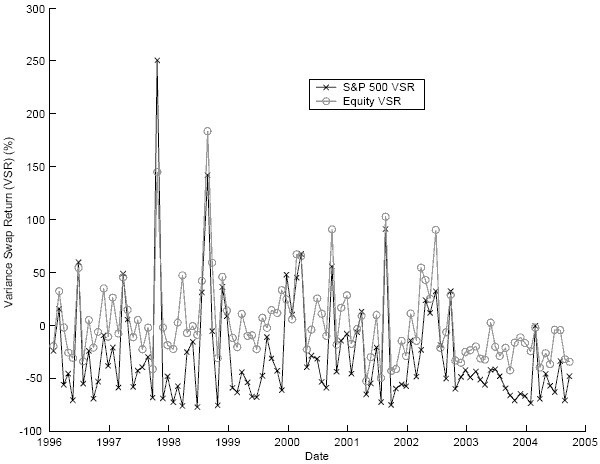Are some types of equity options consistently overpriced compared to others? If so, are there ways to exploit the pricing differences? In the December 2006 update of their paper entitled “Systematic Variance Risk and Firm Characteristics in the Equity Options Market”, Vadim di Pietro and Gregory Vainberg investigate differences in options pricing between individual stocks and indexes and between different types of stocks (small versus large capitalization and value versus growth). Specifically, they examine mismatches between implied and realized (actual) asset volatilities as measured by returns from synthetic variance swaps, which are constructed from combinations of options and futures on underlying assets. Using stock and option prices and associated firm fundamental data for 1,402 firms over the period 1/96-12/04, they conclude that:
- Options on stock indexes are generally more expensive than options on individual stocks.
- A hedge strategy (dispersion trading) that is long a portfolio of equity options and short a portfolio of index options generates, after transaction costs, a Sharpe ratio more than four times greater than that of the broad equities market. Specifically, the strategy yields before (after) transaction costs a monthly Sharpe ratio of 1.04 (0.63) over the entire sample period compared to a monthly Sharpe ratio of 0.12 for the S&P 500 index. This strategy substantially outperforms one of simply shorting index options.
- Options on small and value stocks are more expensive than options on large and growth stocks, respectively. Investors apparently overestimate risks for small and value stocks. Specifically:
- For the 20% of firms with the smallest (largest) market capitalizations, the average implied volatility is 81.9% (41.0%), while the average realized volatility is 75.3% (42.6%).
- Similarly, for the 20% of stocks with the highest (lowest) book-to-market ratios, the average implied volatility is 47.1% (48.8%), while the average realized volatility is 44.7% ( 51.4%).
The following chart, taken from the paper, compares monthly variance swap returns (VSR) for the S&P 500 index with monthly mean variance swap returns for a value-weighted portfolio of equities during 1/96-12/04. These returns are a measure of the mismatch between the implied (meaning expected) volatilities used in pricing options and realized (meaning actual) volatilities. The chart shows that the mismatch is generally larger for the S&P 500 index (mean monthly VSR -28.9%) than for a portfolio of individual equities (mean monthly VSR 1.9%). In other words, prices on options for the S&P 500 index are expensive compared to typical prices on options for individual stocks.

In summary, options for stock indexes are expensive compared to options for the average individual stock, and options for small and value stocks are expensive compared to options for large and growth stocks. Hedge portfolios exploiting these differences may offer abnormal returns.